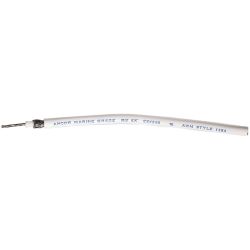RG-213 Coaxial Cable for Long VHF Runs
50 Ohm 13/32" OD Suitable for Longer VHF Runs
Ancor's superior quality coaxial cables feature signal loss ratios up to 50% less than other coax cables. Ancor Marine Grade coaxial cables feature a tinned copper center conductor as well as tinned copper outer braid for corrosion resistance and easy soldering.
Used to carry baseband video in closed-circuit television, previously used for cable television. Will carry a high quality HD signal or video over short distances.
Tinned copper center conductor and outer braid
Tightly woven braided metal shielding provides 96% coverage for best signal strength and least interference
Braid and center conductor are 100% tinned copper for best corrosion resistance and easiest soldering
UV inhibited white jacket for longest life
Stranded core: 7 x 0.0296"
50 Ohm impedance
Maximum attenuation (signal loss) measured at 750 MHz in decibels per 100 ft = 5.967 dB/100 ft. Typically lower loss than RG-58 cable
Outside diameter = 0.405". That's 13/32" - midway between 3/8" and 7/16"
Ancor recommends: RG-213 for VHF applications. Suitable for longer runs over 50 feet.
Heavy on the technical side...
RG = Radio Guide, an obsolete designation, but still useful for identifying compatible connectors.
Coaxial cable, or coax, has an inner conductor surrounded by a tubular insulating layer, surrounded by a tubular conducting shield, typically also surrounded by an insulating outer jacket. The term coaxial comes from the inner conductor and the outer shield sharing the same geometric axis.
Coaxial cable is used as a transmission line for radio frequency signals.
Its applications include feedlines connecting radio transmitters and receivers with their antennas, computer network (Internet) connections, and distributing cable television signals.
One advantage of coaxial over other types of radio transmission line is that in a high quality coaxial cable, the electromagnetic field carrying the signal exists only in the space between the inner and outer conductors. This allows coaxial cable runs to be installed next to metal objects such - as rain gutters outside a building - without the power losses that occur in other types of transmission lines.
Importantly in marine applications, coaxial cable also provides protection of the signal from external electromagnetic interference from other nearby sources.
The ends of coaxial cables usually terminate with connectors. Coaxial connectors are designed to maintain a coaxial form across the connection and have the same impedance as the attached cable.
Connectors are usually plated with high-conductivity metals such as silver or gold. Due to the skin effect, the RF signal is only carried by the plating at higher frequencies and does not penetrate to the connector body. Silver connectors can tarnish quickly, and the resulting silver sulfide produced is poorly conductive - degrading connector performance - making tarnish proof gold-plated connectors a better choice for this application.
